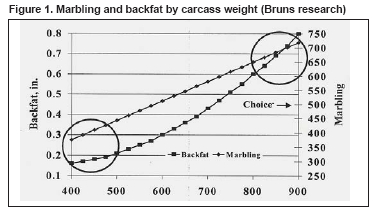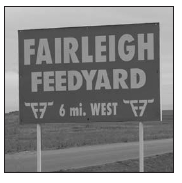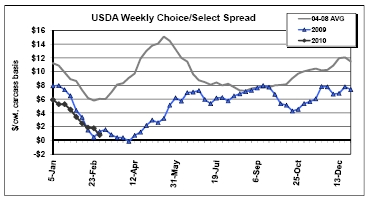
$17.23 per linked Class A and Class B unit USPB Makes Cash Distribution U.S. Premium Beef’s Board of Directors authorized a final cash distribution for tax year 2009. The final distribution, along with the other distributions that were made in the months of May, July, and October 2009, and in January 2010, brought the total distribution to 42% of U.S. Premium Beef’s 2009 taxable income. The final cash distribution per linked Class A and Class B unit was $17.23.w Camera, with USDA oversight, measures Quality grade Instrument Grading Update USPB has been using instrument grading to measure Yield grades since March 2008. USDA graders have been able to use instrument grading data in our plants as a reference for Quality grading carcasses since early 2008. Our company was one of the first in the industry to receive approval to use this technology to call USDA Quality grades. We are now using it to call USDA Quality grades in both our Liberal and Dodge City, KS, plants. According to Steve Crable, National Beef Vice President of Grading Services, the technology enables National Beef’s carcass merchandisers to more precisely and efficiently sort carcasses into various value-added programs. “In short, it allows us to better provide our customers what they want,” Crable says. Carcasses can be sorted not only by specific marbling scores, but also backfat, ribeye area and minimum ribeye width. "Instrument grading also generates valuable information to more accurately track carcasses within the plant and to monitor plant efficiency levels," he adds.w | A look at factors that affect marbling to increase grid premiums Recipe For Marbling–Part 3 By Brian Bertelsen, Director of Field Operations This is the third in a series of articles that looks at factors that have been shown to affect marbling. As mentioned in the previous articles in the last two UPDATES, this is not a discussion of net profit. Instead, it is simply a review of factors for producers who want or need to increase marbling in their cattle. 1. Monitor vitamin levels. Vitamin A is high in lush forages. Supplemental vitamin A is routinely added to grain based finishing diets. However, since it is not very expensive, it is sometimes included at higher levels in the diet. A 2001 survey of 13 consulting nutritionists indicated typical finishing diets averaged 2070 IU/lb (range 1500 to 3300). By comparison, the 1996 Nutrient Requirements of Cattle (NRC) recommends 1000 IU/lb for feedlot cattle. Research has shown high levels of vitamin A inhibit fat cell development. Some feeding trials at The Ohio State University have shown vitamin A restriction can increase marbling and percentage of Choice and Prime without affecting growth performance. However, other trials have shown either no effect or a small numerical advantage to vitamin A restriction. This variability in results could be caused by cattle entering a feedlot after grazing lush forage that have high levels of vitamin A stored in the liver. Research has shown cattle that grazed wheat pasture took over 84 days for their blood level of vitamin A to decrease to a level that was equal to cattle that had been feed grass-legume hay when they entered the feedlot. 2. Consider supplemental Zinc. Published research results are variable; however, some trials have shown an advantage in marbling and quality grade to feeding supplemental zinc. This advantage has generally been associated with an overall increase in fat deposition (both external backfat and marbling). Variability of results is likely associated with differences in body mineral stores at the initiation of the trial. Differences in the absorption of different forms of minerals can also add to the variance in results. 3. Use grower diets containing a moderate to high level of energy, preferably from corn, and avoid prolonged grazing periods during the stocker/backgrounding phase. A recent survey of 100 USPB producers with the highest grading average for all their cattle delivered, showed that 88% were grown in a dry lot. Of those, most were fed a corn/corn silage based grower diet. This is significant for a couple of reasons. First, feeding higher energy grower diets can make more fat cells that will store fat within the meat as marbling. Rumen fermentation of starch from corn produces ...continued on page 2
| |
Reproduction of any part of this newsletter is expressly forbidden without written permission of U.S. Premium Beef. | ||
| Recipe For Marbling... | continued from page 1 | and no creep had the lowest average quality grade. 4. Maintain body condition during backgrounding/growing periods. Another way to describe this practice would be to match total caloric intake to the animal’s growth curve, or their growth potential at that point in their production. One of the first practices abandoned by USPB producers was “roughing” cattle through the winter with minimal inputs until spring grazing. This created a marbling “void” during that period of time in the animal’s life. One of the elusive things about marbling is that it is not compensatory like other tissues. An animal does not compensate with a period of greater marbling deposition after a period of insufficient nutrition. In fact, when compensatory body weight gain does occur, it appears to be mostly in the area of external backfat. Different animals have different growth curves throughout their life. Steers and heifers, large and small framed animals, early and late maturity animals all grow very differently. Likewise, the type and level of growth promotants also have a large effect. One of the elusive things about The main point here is to remember that marbling is excess calories, stored as fat. In addition, marbling is a lifetime achievement. We now understand through research that it can occur throughout the animal’s life. Finally, there is no compensatory gain for marbling. Therefore, the way to increase marbling is to feed that animal throughout its life at a level of nutrition that not only maximizes growth of bone and muscle tissue, but also stores some excess calories as fat. However, as mentioned earlier, too many calories can result in excessive external backfat being deposited too early in the animal’s life. Research by Bruns from South Dakota State University used Angus steer calves that were approximately 8 months of age. They were backgrounded for 70 days and then fed a 90% concentrate corn-based diet. Treatment groups were harvested at target carcass weights of 450, 550, 650, 750 and 850 pounds. Harvest dates ranged from 48 days on the finisher diet, at about 10.4 months of age to a maximum of 252 days on the finisher diet, at about 15.5 months of age. Tissue growth rates were reported relative to carcass weight.
| |
a volatile fatty acid (VFA) called proprionate. Proprionate is converted to glucose by the liver. When growing, developing muscle satellite cells are “bathed” in glucose, some of those cells will become fat cells. Conversely, forage fermentation produces a higher percentage of the VFA called acetate. Acetate has been shown to be associated with external backfat deposition. In addition, lush forages are high in vitamin A, which as mentioned earlier, has been shown to inhibit fat cell development. A second factor is that when calves are grown on limit-fed higher grain diets, they have smaller organ weights. This translates to lower maintenance requirements. Myers conducted a trial at the University of Illinois where all calves were early weaned, but half were immediately adjusted to an 87% concentrate diet and the other half grazed cool season pasture with two pounds of cracked corn daily. After 8 1days, all calves were adjusted to the same finishing diet and were then harvested at less than 14 months of age. Liver and reticulum/rumen weights were about 13% less as a percentage of carcass weight for the steers that were weaned directly onto the high grain diet compared to those that grazed. Another trial at Illinois by Wertz confirmed an advantage in efficiency of early weaned calves grown on high concentrate versus high fiber diets, where intakes were adjusted to achieve the same gain during the growing phase. All calves were then finished on the same diet. Heifer calves grown on the limit-fed high grain diet had a significantly better gain:feed ratio during finishing, compared to those grown on the high forage diet. This means that through lower maintenance requirements, calves that are grown on limit fed high grain diets, can have more excess energy available for marbling deposition during finishing. Obviously, the practice of limit feeding goes hand-in-hand with feeding high grain grower diets, especially to young animals, those that are smaller framed and heifers. When total caloric intake far exceeds growth potential, fat will be deposited. In smaller framed, earlier maturing animals, especially heifers, this can result in light weight carcass discounts and a greater percentage of Yield Grade 4 and 5 carcasses. Feed ingredients seem to make a difference. A University of Illinois creep feeding trial showed calves that were creep fed corn had a higher average quality grade than calves that consumed soyhulls as creep feed. After weaning, all calves were grown on a corn/corn silage diet and were then finished on a corn/chopped hay diet. All other carcass measurements were not statistically different. Total calories still seem to be a major factor. In that same Illinois research, even the soyhull creep fed calves graded better than the controls which received no creep feed before weaning but were grown and finished on the same diets as the calves that were creep fed. Within the corn and the creep fed calves, half were limit fed and half were given unlimited creep. There was a linear increase in quality grade with the unlimited creep calves grading highest, limited creep was intermediate | |||
Marbling increased in a straight line while external rib fat and Yield Grade increased more rapidly relative to carcass weight at the end of the trial. Figure 1 shows the rate of marbling score and rib fat increase relative to carcass weight. This proves that marbling is deposited evenly over a long period of growth and is not just deposited at the end of the feeding period. Therefore, management during backgrounding and early in the feeding period can have a dramatic effect on final marbling. 5. Sort calves during backgrounding or growing periods. Different animals have different growth curves and therefore, different maturity points. This is largely dependent on gender and frame size. Large framed steer calves benefit from shorter backgrounding on higher energy grower diets and then being placed in the feedlot at an early age. This allows them to build up marbling earlier and reach a “market ready” body composition before their carcass weight begins to approach heavy weight discounts. Heifer calves and smaller framed steer calves can be backgrounded longer and then placed in the feedlot later to allow them to harvest with a heavier carcass weight. Sorting into outcome groups can also allow for strategic implanting. More conservative implants can be used on the large framed steers and stronger implants can be used on heifers. Sorting during backgrounding should help to create more uniform feeding groups. Harvesting more cattle closer to their optimum body composition can increase marbling, especially if there are fewer cattle that are under fed and harvested as a Yield Grade 1 or 2. 6. Place cattle in the feedlot and begin feeding finisher diets before cattle get too heavy. Cattle that are placed on feed too heavy will not only have a lower yield or dressing percentage, but they also have a greater potential for heavy weight carcass discounts. If those cattle are harvested before they reach ideal body composition, they will have less marbling. In addition, cattle that are grown or grazed on lower energy diets deposit less marbling. Then, if they are placed on feed too heavy, they will have less total days of excess calories to deposit as marbling. Since marbling is not compensatory, final marbling is a direct result of the total number of days in the animal’s life that it has had excess calories to be stored as fat. Also, cattle that are harvested at an older age can be more susceptible to having advanced skeletal maturity which is a factor in determining Quality Grade. Some carcasses have enough marbling to grade Choice, for example, but if they have advanced skeletal maturity, they can be downgraded to Select. Young maturity is also a specification requirement for branded beef programs like Certified Angus Beef® and Black Canyon® Premium Reserve. Carcasses with more extreme maturity can be classified as Hard Bone or Over 30 months. Next month we will look at some implant and feedlot practices that can result in increased marbling and higher Quality grading cattle.w | Call us if you have delivery rights to lease USPB Delivery Rights Leasing Fast USPB producers continue to lease delivery rights through our facilitated lease program. As was the case last fiscal year, the number of delivery rights for lease is limited. Please call our staff at 866-877-2525 if you have delivery rights you would like us to help you lease to other producers.w | |
Fairleigh Feedyard Deliveries In 1996, when U.S. Premium Beef was merely a concept being talked about by a group of producers who wanted a better marketing system, Fairleigh Feedyard, Scott City, KS, saw the potential. Last month, after delivering cattle every month since USPB opened for business, Fairleigh Feedyard became the first feedyard to deliver more than 1,000,000 head of cattle to USPB. Owner John Fairleigh, who served on USPB's Board from 1998 through 2009, and manager Jerry Kuckelman, believed a system with guaranteed market access on a value-based grid and the opportunity to share in the value added to their cattle through ownership in beef processing, would benefit customers and their feedyard. They were right. Through mid-February of this year, cattle delivered out of Fairleigh Feedyard earned their customers more than $19.6 million in grid premiums. Add to that, Fairleigh Feedyard and their customers, some of which are USPB unitholders as well, have received more $17.2 million in patronage and cash distributions during that time. "We were committed to our ownership in USPB," Kuckelman explains. "We worked with customers to help them understand how to select, manage and market cattle on a value-based system because we believed they would receive more money for their cattle by doing that. In fact, we have customers today who tell us they wouldn't still be feeding cattle if it weren't for being able to sell their cattle through this company. "The grid premiums alone that our customers have received averages almost $20 per head which can be the difference between making and losing money on a set of cattle," he adds. "Being able to receive the value-added money from USPB owning processing has been a real benefit to our customers, especially those who are unitholders, as well."w
|
Benchmark Performance Data Table |
USDA’s Choice/Select Spread The spread between Choice and Select grade beef has been narrow recently due to the world economy’s effect on consumer spending coupled with a larger supply of Choice and a smaller supply of Select grading beef. However, Quality grade continues to be a significant driver of premiums on USPB’s grid. (See Benchmark Performance Data Table at right.)w
Did You Know... üIn order to help National Beef more efficiently market age and source verified (ASV) product to Japan this spring and summer, USPB would like to provide an estimate of the number of ASV cattle our producers will deliver during the months of April through July. Please call our office at 866- 877-2525 to let us know the approximate number of ASV cattle you, or your custom feedyard, plan on delivering during those months. üThe easiest, most efficient way to receive settlement sheets and other USPB communications is via email. If you are not currently receiving USPB information at your email address please send your address to us at uspb@uspb.com . If you do not have an email addresss, we encourage you to consider getting one so you can receive our communications sooner and more efficiently.w
| Base Grid Cattle Harvested in KS Plants 1/24/10 to 2/20/10 | ||||
(Numbers | Base Grid | ||||
Top 25% | All | ||||
Yield | 64.67 |
| 63.91 | ||
Prime | 4.27 |
| 2.89 | ||
CH & PR | 78.25 |
| 73.71 | ||
CAB | 26.34 |
| 20.95 | ||
BCP | 12.81 |
| 11.22 | ||
Ungraded | 1.41 |
| 2.03 | ||
Hard Bone | 0.55 |
| 0.98 | ||
YG1 | 7.65 |
| 10.09 | ||
YG2 | 35.46 |
| 38.33 | ||
YG3 | 46.37 |
| 42.53 | ||
YG4 | 9.97 |
| 8.39 | ||
YG5 | 0.55 |
| 0.66 | ||
Light Weight | 0.29 |
| 0.51 | ||
Heavy Weight | 0.91 |
| 1.71 | ||
Average Grid Premiums/Discounts ($/Head) | |||||
QualityGrade | $20.52 |
| $13.67 | ||
Yield Benefit | $22.12 |
| $9.13 | ||
Yield Grade | -$4.39 |
| -$3.08 | ||
Out Weight | -$1.51 |
| -$2.80 | ||
Steer/Heifer | $1.06 |
| $0.91 | ||
ASV | $9.95 |
| $2.73 | ||
Natural | $2.78 |
| $0.94 | ||
Total Premium | $50.53 |
| $21.50 | ||
USPB Non-Conditional Unit Trade Report | |||||
| FY 2010 Trades | Most Recent Trades - Oct. 2009 | ||||
| # Units Traded | 3,800 | 800 | |||
| Avg. Price/Unit | $153.82 | $149.38 | |||




